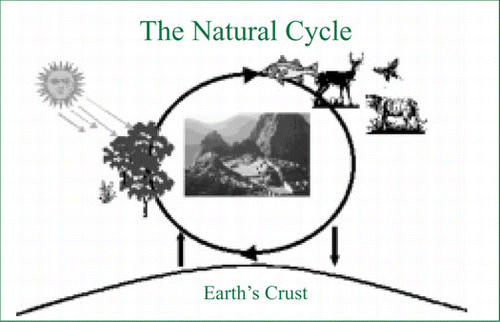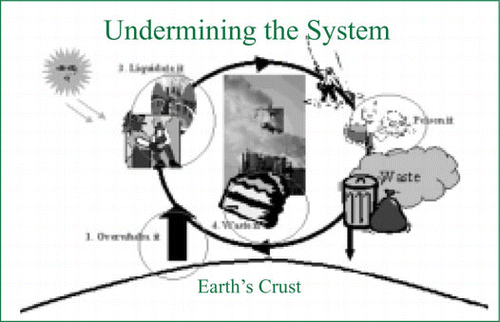Abstract
This article describes a one-day foundation course on sustainable development, based on systems thinking and practice. The course uses dialogue and inter-professional learning to explore approaches to sustainability in a variety of organisational contexts. It introduces the thinking behind sustainable development and provides tools to support the integration of sustainable development principles into professional practice.
Introduction
Amongst the 5.5 million people in the UK who call themselves professionals there is a growing realisation that they need help in understanding how to put the principles of sustainability into practice (CitationMartin and Hall, 2002). Professionals in all sorts of roles increasingly have to demonstrate their competence in complying with complex sets of environmental, social and ethical parameters. These trends have a fundamental bearing on the curricula of higher education programmes, since many professional bodies now rely on accredited degrees as the main route for membership. Many universities have ratified their commitment to ‘playing a leading role in developing a multi-disciplinary and ethically orientated forum of education in order to devise solutions to the problems linked to sustainable development’ in the CitationCopernicus Charter (1993). However, implementation of these principles has proved to be more difficult and progress is frustratingly slow.
Professional Practice for Sustainable Development
It was in this context that a new initiative, Professional Practice for Sustainable Development (PP4SD), came into being in 1999 (CitationMartin and Hall, 2002). This initiative set out to work in partnership with fourteen professional institutions to create a common curriculum framework for sustainable development from which to test and publish training materials. The materials developed were aimed at professionals from varying backgrounds, including business, academia and consultancy. This paper describes the design and delivery of a one-day foundation course in sustainable development (CitationBaines, Brannigan and Martin, 2001) designed and delivered by the PP4SD project.
The Foundation Course - a systems perspective
It was Tolstoy who wrote that the greatest threat to life is habit. Habit, he argued, familiarises us to the point that we no longer really see things. We become incapable of bringing the familiar furniture of our lives into focus. A similar argument can be made about ideas and concepts, and about the intellectual frameworks that shape ideas and concepts. Concepts such as the environment, nature and civil society are familiar and we often take them for granted. Yet they are often difficult to define, partly because they carry with them a variety of implicit assumptions, which influence the way we think about them.
Professionals are no different. Their beliefs and values are largely defined by their long education and training in their basic discipline. Consequently, one of the first steps in designing a foundation course was to create, with the representatives of the professions, an agreed intellectual framework within which to explore the concept of sustainability. The framework (described in CitationMartin and Hall, 2002) has a number of key characteristics:
The earth as a sustainable system is dependent on the activities of a number of well-defined bio-geo-chemical cycles ();
The earth as a sustainable system is open to flows of energy and closed to matter (based on the first and second laws of thermodynamics);
There are four principal ways of undermining the bio-geo-chemical cycles (CitationPorritt, 2000; see );
The framework is set in a future perspective.
By setting the sustainability agenda in an ‘earth as a system’ context, it became much easier for professionals to engage with what needs to be done, rather than focusing on measuring, managing and mitigating downstream environmental impact, as environmental scientists almost exclusively do. The framework provides a mental model for defining what a sustainable world might look like and hence it crucially supports the process of inter-professional dialogue and reflection about the issues and solutions.
The Course Structure
The course structure is based on five overlapping themes:
the principles of sustainability;
an introduction to systems thinking and practice;
tools and techniques for taking a future perspective;
the business benefits of sustainable development;
action planning.
The course begins by asking participants to draw what they understand by sustainable development. Using the drawings as an icebreaker has been an invaluable technique for promoting and facilitating the inter-professional dialogue and learning on which the course depends. It avoids the superficial and often sterile debate on definitions of sustainable development.
Drawings provide useful ways of gathering information about complex situations and are a key element of the approach to systems thinking and practice developed by Peter CitationCheckland (1981) and CitationCheckland and Scholes (1990). Using pictures as a way of thinking about issues is common to several problem-solving methods because our intuitive consciousness communicates more easily in impressions and symbols than words. These pictures attempt to capture the real situation through an entirely freehand, cartoon representation of all the ideas, relationships, influences, causes and effects relevant to sustainable development.
An additional dimension to this approach widely used by systems practitioners is the use of diagrams to explore the relationships or boundaries between systems of interest. The relationship between sustainability and sustainable development is of particular importance here. Whilst these terms are often used interchangeably, they mean different things. In simple terms, sustainability means the capacity for continuance into the long-term future. Sustainable development is the journey or means of achieving the goal of sustainability. In systems thinking, both represent separate but connected systems of interest. To an individual or an organisation, sustainable development represents a ‘sphere’ of influence and action over which they have some control and direction, whereas sustainability, represents a ‘sphere’ of concern, over which an individual or organisation only exerts some limited impact indirectly through their sphere of influence. Identifying a professional’s sphere(s) of influence facilitates a much more focused and productive dialogue on achievable actions and outcomes.
The course also applies a number of techniques to help participants to think in a future perspective because one of the challenges of sustainable development is developing resilient and adaptive decision-making tools that can cope with risk and uncertainty. These techniques include simple scenarios that exemplify the two different approaches we can take to the future and, importantly, how these approaches influence how we act. The usual way of approaching the future is by forecasting which starts from where we are and projects trends over relatively short time intervals, e.g. 1 to 3 years. Planning based on such trends tends to lead to short-term and incremental changes. A major limitation of forecasting is that many present trends are clearly unsustainable! The alternative approach is “backcasting” which starts by taking a 20 to 30 year future perspective based on scenarios or based on the sustainability framework outlined earlier (CitationIson and Blackmore, 1998). The idea is to think imaginatively about the business or organisation to which you belong and to explore a range of fundamental changes that will make it more closely fit the sustainability framework. From each alternative future created, you then work your way backwards from the future towards the present in stages, asking such questions as - what barriers did we overcome; who helped us; who did we need to persuade?
The differences between forecasting and backcasting are critical to how we act in response to the issues of sustainability. Forecasting at best offers a short-term future, but if these trends fail us, then prediction fails us. History teaches us that sooner or later trends fail because change creates deeper more fundamental issues. In contrast, backcasting starts from your anticipated destination (most sensible climbers start planning from the summit that they wish to conquer and work backwards!) and seeks to plot a course of action towards it.
Conclusion
From this brief analysis, it will be obvious that systems thinking and practice forms a core element of the design and operation of the foundation course. It helps to resolve a major issue arising from the use of traditional ways of problem solving, namely its over-reliance on linear thinking. Too much emphasis on linear approaches has already created immense environmental and social problems. This is clearly exemplified by our current approaches to the extraction and use of a variety of natural resources. The course as outlined here has been successfully trialed in over twenty different inter-professional settings. It has evolved and continues to change through a process of stakeholder evaluation and reflective practice.
References
- BainesJ., BranniganJ. and MartinS. (2001) Professional Partnerships for Sustainable Development. (Institution of Environmental Sciences, London)
- ChecklandP. (1981) Systems Thinking, Systems Practice. (Wiley, London)
- ChecklandP. and ScolesJ. (1990) Soft Systems Methodology in Action. (Wiley, London)
- Copernicus Charter. (1993) http://www.copernicus-campus.org/sites/uni.html
- IsonR. and BlackmoreC. (1998) Post Graduate Programme in Environmental Decision Making:T860 Environmental Decision Making:A Systems Approach. (The Open University, Milton Keynes)
- MartinS. and HallA. (2002) Sustainable Development and the Professions. Planet, 3: 17-18.
- PorrittJ. (2000) Playing Safe: Science and the Environment. (Thames & Hudson, London)

